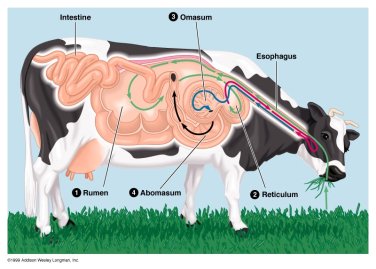You have probably seen cows contentedly enjoying a nice mouthful of grass. Basically, there are grasses everywhere you go; and although it’s a well-known fact that humans can live well and thrive on a totally vegetarian diet, eating grass unfortunately wouldn’t do much for us. So what’s the difference? Why can’t humans digest grass if cows, goats and sheep can?
Turns out humans just don’t have the required enzyme needed to break down the cellulose in grass. Our digestive systems just aren’t prepared for it.
Cellulose is a complex carbohydrate that makes up most of a plant’s cell walls. It consists of linear chain of several hundred to many thousands of glucose units known as polysaccharides that plants use to build their walls. Cellulose is present in basically all plants, like spinach, kale, and grass. Most of the plants we eat have some nutrients we can digest. But grass is basically all cellulose, which is indigestible for humans.
How does a cow’s digestive system work?

When a cow chomps on some grass, it travels down its esophagus – the part of the alimentary canal that connects the throat to the stomach, then all the way into its four-chambered stomach. And after the grass gets partly digested, it passes down to reticulum, the second chamber of stomach where chunks of grass called cud are formed.
The next step is regurgitation. The chunks which were form in reticulum (the second chamber) are returned to the mouth so the cow can grind them up a little more and break down the food even further.
The cow swallows the grass again, and this time it makes its way back to the stomach. It’s not just the cows that do this – goats, sheep and other ruminants regurgitate their food too.
How Does Cellulose Digestion In Cows and Other Ruminants Take Place?
The rumen – the first and largest of four chambers of the stomach of a ruminant, including cows – is where the main grass-digestion happens. In rumen live the tiny microbes. These microbes digest the cellulose in the grass without oxygen, in a process known as anaerobic digestion. The process involves two main steps: Enzyme production and fermentation.
In enzyme production, the microbes in the rumen release certain enzymes, like cellulose which helps break down the cellulose. The enzymes, acting as catalysts, hydrolyze the cellulose, so that they can split them up into smaller carbohydrates like glucose.
From there, the leftover, smaller carbohydrates are fermented in the third chamber of the stomach, omasum, and they later gets absorbed as nutrients. After that, the partly digested grass eventually makes it to the abomasums – the fourth chamber, and the acidic part of the stomach that is similar to humans’. In this fourth chamber, the food is digested even more and eventually passes it to small and large intestines.
So as a matter of fact, the main players in grass digestion of the ruminants are the microbes that produce enzymes needed to break down cellulose. Humans just don’t have them. Well, humans do have the enzymes to digest other carbohydrates, like starch and simple sugars.
Can You Digest Grass If Put The Same Microbes That Are In A Cow’s Rumen In Your Stomach?
No. Because the pH of humans’ stomach is around 1 to 3, which is way too acidic for cellulose-digesting process to happen, whereas, the pH of the cow’s rumen is around 7, which is neutral. The microbes stop breaking down cellulose at a pH of 5.5 or lower, so putting microbes in your stomach wouldn’t give you the ability to digest grass.
Even if the microbes are made to stay in your small and large intestines, it wouldn’t make much of a difference. Another option might be to just swallow some cellulose, but you don’t know what consequence it would have on your body. Humans can’t definitely eat (or live on) grass. It’s best to leave them to the cows.

The article is gleaned originally from Scishow’s – ‘Why Can’t You Digest Grass?’, but with added details and more credible sources (already included in the video description). If you’re interested, you can watch the video below.

Im learning about this for University so pretty cool!
LikeLike
Very interesting topic
LikeLike
Good topic choice!
LikeLike
Thanks. 🙂
LikeLike
Really fun in its random subjects !! 🙂 Liked your blog style 🙂
LikeLike
Thank you! 🙂
LikeLike
I guess seaweed is about as close as we are going to get.
LikeLike
I guess so, too. 😛
LikeLike
Are roots of grasses edible for humans ?
LikeLike
I don’t think so; there can still be cellulose.
LikeLike
When you see cats and dogs eat it too, questions like this do arise.
LikeLike
Some say to induce vomiting, some say they do just because they can. I will definitely write something about it. Thank you for reminding. 🙂
LikeLike